
The Emergency Amateur Radio Club (EARC) 146.88 MHz Diamond Head Repeater
For over 40 years, the Emergency Amateur Radio Club (EARC) repeater on Diamond Head has greeted visitors and residents alike, providing welcome VHF and UHF amateur radio coverage for hand-held walkies, mobiles and home units. In 2014, the long history of this fabulous repeater comes to an end.
We will look at the historical aspects of the crater at Diamond Head, and how it influenced the creation of one of the most famous VHF amateur radio repeater in Hawaii.
Modern Historical Background of the Diamond Head Crater
The modern history of Diamond Head involved the federal government. In 1893, the governance of Hawaii transitioned from a monarchy to a republic. The Republic of Hawaii was annexed by the United States and became a territory of the United States on June 30, 1899.
Pearl Harbor proved to be a strategic military asset in the Pacific to the United States and efforts began to dredge and improve the harbor as a naval facility. Likewise starting in 1904, Diamond Head Crater was purchased by the Federal government and improved by the military to be used for coastal defense of Oahu's southern shores.
During World War I, gun emplacements were placed upon sites on the rim and summit of Diamond Head. By 1943, five artillery batteries were built within and around the crater. This web page offers great insight into the history and content of the military installations around Diamond Head.
In the late 1950’s, trans-pacific air traffic increased as a result of the emerging use of jet airliners. The jet engines were generally more reliable than the rotary piston engines used on propeller-driven aircraft and the higher altitudes and faster speeds made the California-to-Honolulu flights more practical for the Boeing 707 and Douglas DC-8 jetliners. In 1961, the FAA created offices and a regional air traffic control center within Diamond Head crater to handle the additional air traffic control.
In 1962, Executive Order 2000 signed by Governor Quinn created the Diamond Head State Monument. Act 249 in 1965 by the Hawaii State Legislature designated the Diamond Head State Monument a historic site. In 1968, Diamond Head was designated a National Natural Landmark.
Aerial view of Diamond Head Crater
Diamond Head is an extinct volcanic crater, nearly circular in shape. The summit which overlooks the Pacific Ocean and Waikiki Beach rises to an elevation of 754 feet. The opposite end of Diamond Head crater rises to an elevation of 481 feet above sea level.
Below are a side view looking southeast of the crater exterior and aerial photos of the crater interior.
 |
Southeast View. This is the most recognized view of Diamond Head. This photo is taken of the west side of Diamond Head looking from the northwest to southeast. Waikiki and Waikiki Beach are to the right and the Pacific Ocean is in the background of the photo, and the mountains of the island of Oahu are on the left. The distinctive summit on the right was created hundreds of thousands of years ago as a result of the the prevailing northeast trade winds blowing on the lava spouting from the crater floor and depositing the lava onto the southwest crater rim. The EARC repeater site is located on the portion of the crater rim on the left. |
 |
The repeater was located within an abandoned artillery gun emplacement bunker at the North rim of the crater in Huling Tunnel. This is the view from north of the back rim with the key locations annotated. The scenic lookout and the entrance to the Kahala Tunnel is on the left, below Huling Tunnel which is on the crater rim. |
 |
Mauka or Mountain View. The next view is the view most often seen by visitors departing Honolulu International Airport heading East towards the mainland. As the plane clears Waikiki Beach, Diamond Head emerges below with the Koolau mountains visible in the background to the North. The altitude of the plane at this point is typically around 7,000 feet. Along the top part of the crater floor in this photo, you can see buildings belonging to the National Guard. You can also see the access roads leading from the crater floor along the crater wall up to the rim site along the back crater wall. |
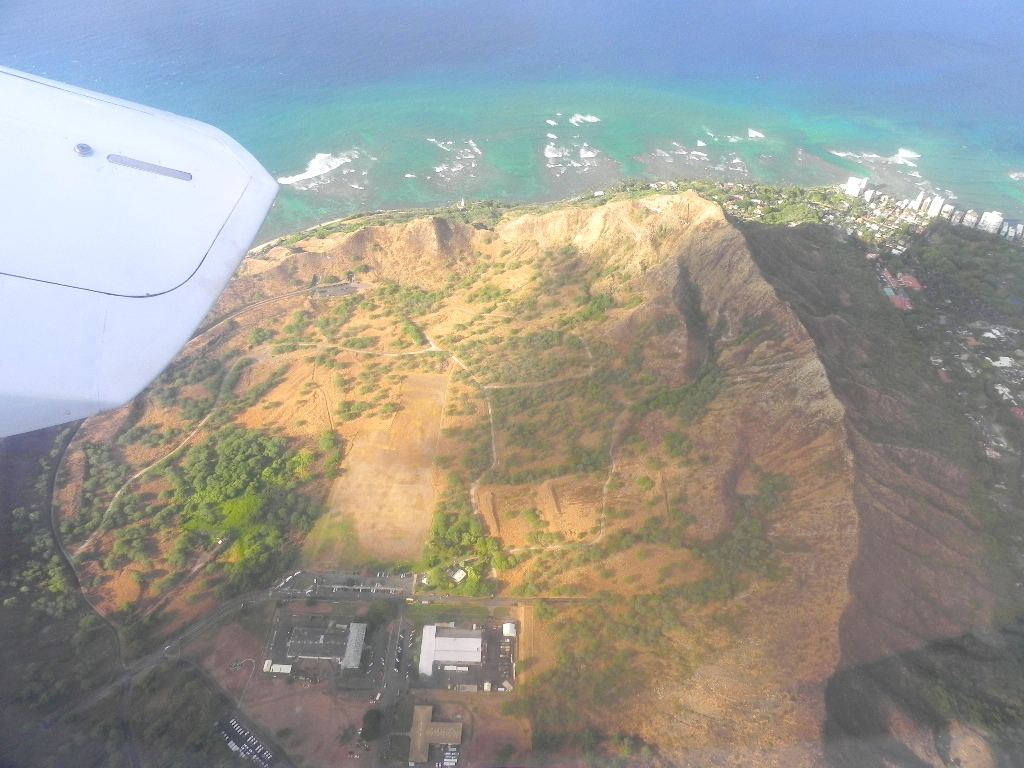 |
Makai or Ocean View. This view was taken from a light aircraft just north of Diamond Head, looking south towards the ocean. Light aircraft flying this route are typically flying under Visual Flight Rules (VFR) at an altitude of around 2,000 feet to keep them separated from the commercial jet airliners. You can clearly see the buildings for the National Guard, as well as the main parking lot for visitors to Diamond Head Crater park. The location of the EARC VHF/UHF repeaters is on the crater rim directly below this aircraft and is not visible in this photo. |
The Advent of VHF FM communications and Early Two Meter FM repeaters
There were a lot of surplus radios left over from WWII. Of note were aircraft radios which used the VHF frequency band and AM during the war. The VHF aviation frequency band and AM modes are still in use today. Some of them were modified to work in the amateur radio bands. A popular amateur radio of the post-WWII era was the Gonset Communicator which operated on Amplitude Modulation (AM) and required a tuning eye.
Frequency Modulation (FM) techniques for two-way communications began during World War II. After the war, two-way FM communications became popular with law enforcement and public safety agencies, taxi companies and other businesses that used two-way radios to communicate with a fleet of vehicles. Two-way FM radios were ideal as it was easy to operate, didn’t require frequent retuning like that of AM or SSB communications and were relatively immune to interference from electrical sources.
The range of the VHF frequencies used by the FM radios was generally limited to as far as one could see. The horizon or surrounding terrain, nearby mountains, buildings or other large obstructions would limit the range of mobile communications. To extend the operating range of the radios, automatic relay stations known as repeaters were installed atop high locations such as mountain tops or tall buildings. The operators of the mobile units would talk and transmit their messages to the repeaters on the "input" frequency, and the repeater in turn would retransmit the same audio message on a new "output" frequency. The other mobile radios would receive the audio message by listening to the output frequency and thereby benefit from the increased range of communications.
Early radio equipment for VHF FM used precision-crafted crystals for keeping the radio transmissions tuned to the assigned radio frequency "channels". Traditionally, radios required the operator to manually tune the radio to the exact frequency of the other units. The nature of the new FM radios allowed it to automatically tune for slight variations in received frequencies and maintain consistent audio levels regardless of the strength of the signals received from the other units. Combined with the smaller sizes for VHF radios, these characteristics made VHF FM two-way radios popular with operators of mobile units.
Since these FM radios were used for mobile and portable operations, the antennas for these radios were mounted vertically, often with antennas that were vertical polarized and omni-directional. Vertical antennas on the vehicles and on the base stations or repeaters meant that signals could be transmitted and received in mostly any direction, regardless of whether the vehicle was moving away or towards the other operator or repeater.
Before 1977 there were two sub bands available for amateur radio repeaters in the two meter band. The two meter band in the United States ranged from 144 to 148 MHz, and the two repeater sub bands were 146.00 to 147.00 MHz, and 147.00 to 148.00 MHz. The frequencies from 144.00 to 146.00 MHz were reserved for AM, SSB, CW and weak signal work. The early repeaters and simplex channels were channelized on frequencies that were separated by 30 kHz (30 kHz channel spacing). As the years progressed and the popularity of two meter repeaters grew, an additional sub band from 144.80 to 145.80 MHz was added and the band plan moved to a 20 kHz or 15 kHz channel spacing.
Generally, open (public) repeaters were assigned to the 146 sub band, and closed repeaters were assigned to the 147 sub band.
In the early days of crystal controlled radios, the frequently available channels were on
146.94 simplex, 146.94-, 146.52 simplex, 146.76-, 146.88-, 146.82- MHz.
This convention carries into the current day, as evidenced by these frequencies being preprogrammed into the
Radio Shack PRO-485 Desktop Scanner Receiver.

In those days, information was spread via word-of-mouth, mimeographed or photocopied handouts at the electronics store - even articles published in newspapers and magazines. There were no repeater directory books, email or the Internet to spread the information. By convention across the nation, the location with the best repeater coverage was assigned the repeater frequent of 146.94 MHz, so that travelers would try that frequency first as a repeater frequency or calling directly on simplex to make a contact.
In the early days, the use of the CTCSS sub audible tone was not needed as adjacent channel interference and inter-mod was generally not a problem. If contact was not made on 146.94 MHz, contacts were attempted on simplex channel 146.52 MHz and a second repeater pair 146.76 MHz which was often available as a “local” repeater serving the main towns along the travelled highways.
Origins of the 146.80 VHF Repeater
The first Radio Club in Honolulu was the Honolulu ARC which started before WWII. The radio club was shut down during WWII after the attack on Pearl Harbor, but was later revived after the war. This part of history is not well documented. By the 1960’s the HARC club meetings were held at Building 22 in Fort Ruger. The members were active in Army Mars and early emergency communications. They had a Collins S line HF station and ran radio telephone patches with the soldiers in Viet Nam.
The Honolulu Fire Department donated their old surplus radio equipment to Oahu Civil Defense Agency which could be reused to provide emergency communications on the amateur radio bands. The EARC Club was created as a vehicle for sponsoring education and alignment with the then Oahu Civil Defense Agency (OCDA), which is now known as the Department of Emergency Management (DEM). The EARC was the vehicle for coordinating contributions of individuals in partnership with OCDA and the contributions of community volunteers. Art Spitzer, an attorney, assisted with the paperwork to incorporate the group as the Emergency ARC in 1972. The Honolulu ARC and the EARC were really one and the same back then. It was only in later years that they separated into the two club entities we have today.
EARC charter member “Doc” Lam, KH6GG spearheaded projects in cooperation with OCDA to place amateur radio repeater equipment on Diamond Head. The original repeaters on Diamond Head included a six meter FM repeater and a ten meter FM repeater. The fire department equipment surplused to OCDA was a tube type Motorola repeater on the VHF “Low Band”. OCDA and EARC were able to put up the modified repeater on the back side of Diamond Head with an input of 52.525 MHz and an output of 53.520 MHz. They used two separate antenna sites for added isolation of the receive and transmit frequencies. The Receiver was located at what was called “the blockhouse” and the transmitter was at Huling Tunnel putting out about 600 watts.
Huling tunnel was previously used as a gun battery for two 4.72 inch coastal defense cannons. Huling was located almost directly above Kahala tunnel, which is the main entrance into Diamond Head crater. Hundreds of visitors a day go through Kahala tunnel to enter Diamond Head crater.
Huling was comprised of two parallel concrete-lined tunnels about one hundred feet long and forty feet below the top of the crater rim. The entrance to the tunnels was from an access road on the inside of the crater and the tunnels led in a northeast direction towards the exterior of the crater. The two parallel tunnels were connected by another tunnel, forming an “H” pattern underground just below the crater rim.
Towards the exterior end of the tunnel, the tunnel had a set of stairs that rose twenty feet to a concrete covered platform that previously served as the mount for the cannon and was located just below the rim of the crater. The exterior opening of the platform had visibility from the Koolau Mountains eastward overlooking the shores of Kahala, Wailupe, Aina Haina and Hawaii Kai. The cannons at Huling would be have been used to disrupt a landing by enemy forces upon those beaches. The EARC six meter repeater was located in the Ewa tunnel, with the antenna mounted on a utility pole at an elevation of 448 feet.
The platform area also served as a radio room for a number of governmental agencies. Originally the platform was open to the exterior of the crater. In the early 1990s homeless people started entering and occupying the tunnels. The platform entrance was sealed with hollow tile blocks, leaving a small opening near the top of a couple of inches for the antenna cables to exit to the antennas mounted on utility poles on top of the crater rim.
Around 1968, a friend of Doc Lam KH6GG Howard Ballenger came to Honolulu to sell cleaning products primarily to Al Phillips the Cleaner. He was active with the Grizzly Peak repeater group in California. That repeater operated on 146.80 so through negotiations the club put up a two meter repeater on Diamond head using the same sites as the six meter machine. It was established using the frequency 146.80 MHz.
Doc Lam teamed up with several individuals to place a two meter FM repeater on Diamond Head. The team comprised of Larry Villados KH6BVS (Hawaiian Telephone Company), Bob Schneider KH6FNB/AH6J (UH Student), KH6GKD, Jules Vetter KH6YU (KGMB-TV broadcast engineer), Pat Corrigan KH6GQW/KH6DD (US Customs), and Bob Terry KH6CIZ. Others involved were Tim Kolb KH6DM (USArmy, Comsat later FAA), Howard Ballanger (from California), Gary Cosendine KH6GFG (USN later AMFAC), and many others.
The early two meter repeater was a surplus commercial General Electric (GE) "Pre Prog" repeater modified and retuned to transmit on 146.80 MHz on the two meter band. A Phelps-Dodge Station Master antenna mounted upon a wooden utility pole provided good antenna gain for the system. The heliax was aluminum jacketed hardline recycled from previous military equipment. As a national standard emerged repeater channels, by 1974 the repeater was recrystalled and retuned for 146.28/146.88 Mhz pair.
The number of two meter users was so small in those days that the two and six meter machines were connected together to accommodate them. One of the early users of two meters was Tim Kolb KH6DM, using a Comco radio in his Charger. Tim worked at Comsat at the time. He used a GAM TG3 antenna (common called the Beer can antenna). Police were also using the same antenna for their VHF radios in their vehicles. Tim's vehicle was identical in many respects to a police car traveling along the North Shore. The police never cited Tim for impersonating an officer but they would often salute him.
With the prevalence of KHON-TV on Channel 2, it soon became apparent that the six meter repeater would have to be shut down because of co-channel interference in the residential areas with TV Channel 2. TV Channel 2 is on 55 MHz and the receivers on the TVs were too broad to reject the signals from the repeater on 53 MHz.
The stations with a good antenna could access the two meter repeater from:
- Parts of Maui, Lanai, Molokai and the heights above Kona on the Big Island to the east
- The southern portion of Oahu from Hawaii Kai and Koko Head to the east and Kalaeloa, Kapolei and Makakilo to the west.
- The windward side of Oahu from Waimanalo through Kailua, and parts of Kaneohe through Valley of the Temples to Kualoa Beach park.
- Parts of Haleiwa and Wailua on the North Shore.
- Central Oahu from Haleiwa through Mililani through Pearl Harbor.
Communications on repeaters between mobile or portable stations were favored as the time spent on the repeater would be somewhat limited for any given contact. Requests for phone calls to 911 for police assistance with traffic and similar situations could be heard on occasion. Long contacts between two or more fixed stations were encouraged to use a simplex channel where possible. Often, the longer contacts would involve welcoming visitors to Oahu, making their acquaintance, and giving suggestions on places to go and things to see.
In time, the Diamond Head repeater grew to become the western end of an inter-island EARC-BIARC two meter repeater system. The Big Island Amateur Radio Club (BIARC) was formed to sponsor the Big Island portion of the system on the eastern end with a repeater at the 8,000 foot level of Mauna Loa on the Big Island. BIARC started out as the Hilo Branch of the EARC and later separated to its own club. The Mauna Loa repeater was at the former KBMB microwave site that use to relay TV signals from Maui to the TV transmitter site in Hilo.
In the middle was the EARC repeater atop Mount Haleakala on Maui about the 10,000 foot elevation. While EARC retained control of Haleakala, credit must be given to the Maui ARC for support and upkeep. The repeater would not have been possible without their help.
The repeaters were linked via UHF radios. The central UHF site was a UHF repeater at the IFA equipment shed at Science City atop Mt. Haleakala on 444.15+ MHz, and the Diamond Head and Mauna Loa VHF repeaters used UHF link radios tuned to 449.15- MHz. The UHF repeater was connected to the VHF repeater at the KGMB/KMVI-TV transmitter building across the road via a dedicated four-wire cable. A transmission on any of the three VHF repeaters would activate the UHF link, with the link audio signal relayed through the Mt. Haleakala UHF repeater to the UHF link radios at other two repeater sites. The UHF link radios and repeater would then activate the corresponding VHF repeater at each of these three sites. Towards the end of its useful life, the VHF repeater was fitted with a Scala VHF repeater antenna until it was damaged in a severe winter ice storm around December 1994.
The location, frequency and repeater call signs were
| Diamond Head, Oahu. Huling Tunnel, Ewa gun emplacement | 146.80-, later changed to 146.88- | KH6EQF, WR6AGE, KH6BM, WH6CZB | Linked to Mt Haleakala via 449.15- UHF link radio and four-element, ground mounted yogi antenna. |
| Mt. Haleakala, Maui. KGMB/KGMV-TV transmitter building. | 146.94- | KH6EQK, WR6AGD, KH6RS | 20° 42′ 30″ N, 156° 15′ 19″ W; 20.708333, -156.255278; UHF Link repeater on 444.15+ at the IFA equipment shed. |
| Mauna Loa, Big Island. | 146.82- | KH6EQN, WR6AGF, KH6FNB, AH6J, KH6EJ and WH6FM | Linked to Mt Haleakala via 449.15- UHF link radio |
| UH Manoa, Oahu. HIG Building | 146.76- | KH6FOX (now decommissioned) | Noel Thompson (moved to Oregon) |
| Wailuku Maui. County Building | 146.76- | ||
| Kulani Cone, Big Island | 146.76- | KH6EJ | |
| Diamond Head, Oahu. Pillbox ewa of crater rim access road. | 444.50+ | EARC UHF repeater. Now co-located with the EARC VHF repeater. |
Over time, other amateur radio operators were involved in the maintenance of the Diamond Head repeater. Included were: Joe KH6GDR, Al KH6INY, Robin KH6IIX/AH6CP,Doug KH6JQW, Ken WH6FR, Bernie KH6IAH, Hart KH6BIO, John KH6HLD/AH6BJ, Tony AH6BW, Jim KH6JKG, Ken KH6IQV/KH7R, and Ron KH6JCA/AH6RH.
Later upgrades and replacement of the Diamond Head VHF repeater were:
- VHF Engineering repeater
- Motorola Micor repeater
- Motorola MSR-2000 repeater with a Diamond F-23 antenna
During the latter 1970's through the early 2000's, the Diamond Head repeater was linked via State Civil Defense microwave and a four-wire interface to the OCDA Emergency Operating Center in the basement of the current Frank Fasi Municipal Building. It was possible to control and transmit on the EARC Diamond Head repeater from the Centracom console in the EOC.
The heliax was replaced on Feb 7, 2009 with a piece of surplus 7/8-inch hardline. The replacement hardline substantially improved the feed line transmission characteristics and greatly improved the audio of the MSR-2000 repeater. Mobile operators easily could be heard traveling on Moanalua Road on the back side of Red Hill where previously that section would result in noise and “picket-fencing” even with mobile units using 25 watts of power.
A separate stand-alone GE UHF repeater on 444.50+ MHz was located in a pillbox just Ewa of the access road that services the sites along the back side of the crater rim. The pillbox sits on the rim site above the Kapiolani Community College (KCC) campus and Leahi Hospital. The standalone UHF repeater featured an auto patch, That stand-alone UHF repeater was eventually replaced with a Motorola repeater and moved to the same site as the VHF repeater. It replaced the UHF link radio when the inter-island repeater system was dismantled around 1998 and was tied into the VHF repeater link audio as a cross-banded repeater.
Repeater Coordination
FCC tried to establish the KH6EQ* series of call signs for clubs in Hawaii but this quickly faded as the available callsigns were used up. The FCC then tried to establish the WR6 prefix for repeaters. As part of repeater deregulation, the FCC would no longer issue special repeater call signs but allow clubs or individuals to use their call signs to identify the repeaters. In Hawaii, the WR6 prefix used for repeaters faded out of existence.
The FCC would also no longer review the technical requests for repeater call signs and operations and instead allow the amateur radio community to determine frequency coordination and the assignments of the repeater frequencies.
In the early 1970s, the need for a central person to compile and coordinate the use of frequencies for the repeaters became evident. Noel Thompson KH6FOX of UH Geophysics Department served as Hawaii’s first repeater frequency coordinator. His office was in the HIG Building which housed the 146.76 KH6FOX repeater and an HP-2000 ACCESS BASIC timesharing computer. Noel wrote a BASIC program to calculate intermodulation products of common high-powered transmitter frequencies such as AM and FM broadcast stations, Honolulu Police and Fire Department radios, amateur radio repeaters and VHF paging systems.
The VHF paging systems were especially troublesome as the transmitter outputs were several hundred watts into high gain antennas that produced a very strong signal. Combined with the high power signals TV and FM broadcast transmitters atop the Ala Moana Hotel, Century Center, the KGMB-TV tower and the Hilton Hawaiian Village, amateur radio mobile and handheld radios traveling the corridor along Kapiolani Boulevard from McCully Street to the present day Convention Center was especially prone to intermod interference.
Noel’s program would determine if the mix of intermodulation products from two transmitter sites would fall within 10 kHz of a given amateur radio repeater’s input or output frequency. The program was comprised of two FOR/NEXT loops, which selected permutations of two transmitters. Within the two FOR/NEXT loops, two additional FOR/NEXT loops would calculate the higher order harmonics (i.e., the fundamental frequency, second harmonic, third harmonic, etc) of each of the two transmitters. The program compared the individual harmonics as well the sum and the difference of the harmonic frequencies to determine the intermodulation mix products. If these products were within a prescribed amount of the set of amateur radio repeater input and output frequencies (typically 10 kHz), the program would flag the combination of the two harmonics as a potential problem with intermod.
Operating Events
The early use of the Diamond Head and other repeaters emphasized and encouraged communications between mobile and portable units. Visitors to Waikiki and Oahu would frequent the repeater and enjoy contacts with the residents to get tips on where to go, what to see, and where to eat while in town. Communications between fixed stations were occurring on the repeater.
The EARC-BIARC Inter-island repeater system enjoyed a few interesting operating events. During brief periods in the summer months between June and August, the trans-pacific weather conditions between the Big Island and the West Coast near Los Angeles, California would be just right to support the propagation of two-way VHF FM transmissions between these two locations. When the conditions were right, stations near the coastline of California could access the Mauna Loa VHF repeater over 2,500 miles away, and have their signals further relayed to Maui and Oahu. Similarly, the Hawaii hams could talk to the California contacts during these precious moments.
The weather conditions would typically last an hour or two but it may last shorter or longer. Normally, the temperature of the air would decrease as one goes further up in altitude. When warmer, dry air would settle in (typically in the evening) above cooler, slightly moister air at the lower altitudes, it would permit a special form of radio propagation known as tropospheric ducting. It forms a wave guide made of varying qualities of air such that the VHF or UHF radio waves at the higher altitude travels slightly faster than the radio waves at the lower altitude. That causes the radio wave to refract or bend slightly downward towards the horizon and allow it to travel hundreds of miles along the curvature of the earth.
This weather condition is known as a temperature inversion and would occur at altitudes of a couple hundred feet near California and increase to altitudes of a few hundred or thousands of feet near the Big Island. Stations in California would get advance notice of the event by listening for the radio beacons atop Mauna Loa located near the Mauna Loa repeater. Stations on the Big Island in the higher elevations above Hilo would get advance notice when the FM broadcast stations from the West Coast can be heard exceptionally clear and strong. As the temperature inversion rose at the Big Island end, it would encounter the Mauna Loa repeater at the 8,000 foot elevation and carry the radio signals to the coastline of California.
Due to the recurring tropospheric propagation through the Big Island repeater at 8,000 feet, Paul Lieb KH6HME obtained permission to use the Mauna Loa site for propagation experiments and put up various VHF and UHF beacons at the site. Paul was able to establish direct communications contact with the mainland on frequencies up to the 5.760 GHz (microwave) band and accomplished what a couple decades before was thought to be impossible. Paul was recognized for his pioneering achievements in 1999 receiving the Dayton Hamvention Special Achievement Award for "his pioneering and record-setting work in tropospheric ducting and VHF, UHF and microwave communications." After he passed away a memorial brick was placed in the Patio at ARRL Headquarters in Newington, CT.
The EARC Diamond Head VHF repeater is the main VHF repeater for OCDA/DEM RACES alerts, and provided radio communications during emergency events involving the island of Oahu. It is used for the annual ARRL Simulated Emergency Test (SET) and Makani Pahili State hurricane exercises. Past events include:
- May 7, 1986 - Tsunami alert due to an earthquake in Adak, Alaska
- December 31, 1999 - Year 2000 radio watch
- October 15, 2006 - Kiholo earthquake on the Big Island and resulting Oahu-wide power outage
- December 26, 2008 - Oahu-wide power outage.
- February 27, 2010 - Chilean earthquake and tsunami watch.
- March 10, 2011 - Tohoku-Sendai Japan earthquake and tsunami watch.
- May 2, 2011 - Twin waterspout formation near Honolulu Harbor.
- October 27, 2012 - Queen Charlotte Island earthquake and tsunami watch.
The latter 1970s
Around 1976, advances in radio and repeater technology caused booming growth of the two meter repeaters. IC chips, PLL frequency synthesizers, simple microprocessors and improved RF transistors for receiving and transmitting caused advances in the functionality and use of the handheld and mobile radios. Instead of being limited to a few channels that were crystalized, the operator could “dial-up” any of the frequency channels using the digital frequency synthesizers found in the newest radios. Rather than spending $10 a channel for crystals, the owner could spend perhaps $100 to $150 more for a synthesized radio and have the freedom to operate on any simplex or repeater channel.
With the increased demand for repeaters and frequencies, the FCC in 1977 deregulated some of the rules for repeater operations, and created a third repeater sub band from 144.60 to 145.80 MHz. In parallel, the amateur radio community changed the channel spacing from 30 kHz to 20 or 15 kHz in order to make more repeater frequency pairs available.
Noel KH6FOX retired and moved to the mainland and KGMB engineer Jules Vetter assumed the job. After that Pat Corrigan, KH6GQW/KH6DD stepped in as the third Frequency Coordinator. In time, the Hawaii State Repeater Coordination Council was formed to work with Pat. Around the year 2000, Pat retired and later moved to the mainland and Rick Ching KH6JJX/KH7O became the fourth Frequency Coordinator. Rick began publishing the Hawaii Frequency coordination information at his web site.
Site Photos
|
|
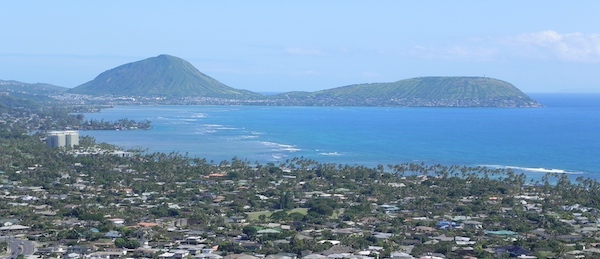
View of Kahala. This is the view to the east overlooking Kahala beach, with Wailupe, Aina Haina and Hawaii Kai in the background. |
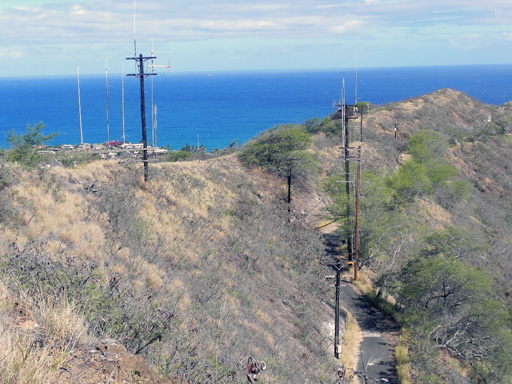
The view of the rim site, looking east in the general direction of Maui. The entrance to Huling tunnel is from the access road in the lower right corner of the photo. The entrance is near the white dust on the road. |
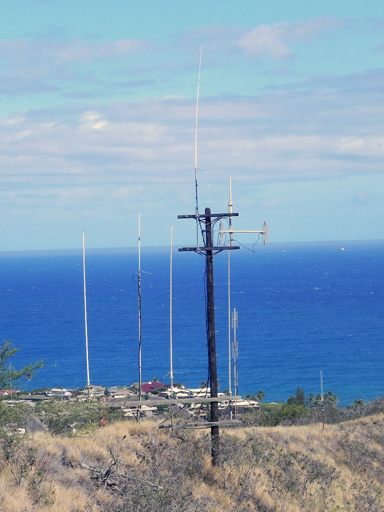
A closer view of the wooden utility pole supporting the Diamond F-23 antenna for the VHF repeater. It is the tallest antenna in the photo. |
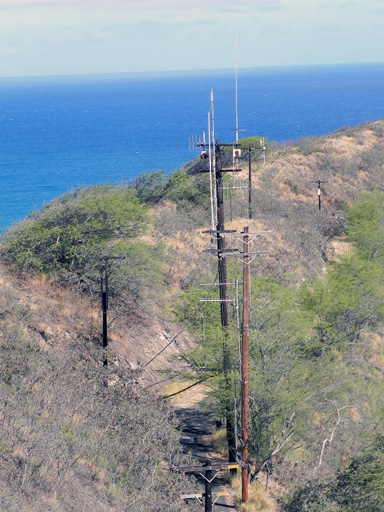
A closer view of the wooden utility pole along the access road supporting the Phelps-Dodge antenna for the UHF repeater. It is the antenna farthest from the camera. |

Continuing towards the right, the view of the floor of the crater, leading up to the summit. |
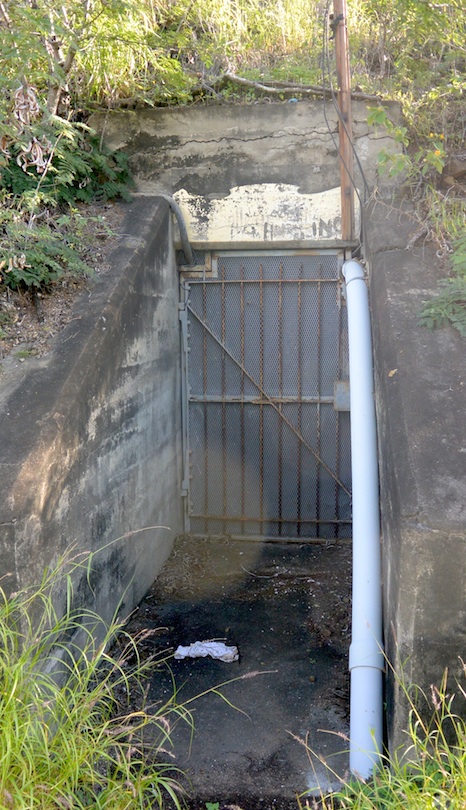
The Ewa entrance to Huling Tunnel, from the access road. |

In this file photo circa 2000, we have these folks working on the 146.88 and 444.50 repeaters: Don KH7V, Ralph NH6PY, Jim KH6JKG, Mike WH6CSB and Russell WH6DBI. Note the hollow-tile wall behind the work crew enclosing the gun emplacement. |
The EARC Nightly Net
Around May 1986, Bob N4ESX decided to start a nightly net on the Diamond Head repeater. He convened the net at 7:30 pm and would be the nightly net control station (NCS) for up to thirty days, with the understanding and expectation that others would sign up to be NCSes. Ron KH6JCA/AH6RH became the second NCS and started the Sunday evening timeslot. Other operators joined in and the nightly net became a standing feature of the Diamond Head 146.88 MHz repeater.
Ray NH6K was a regular on the net, checking in from the heights above Kona on the Big Island. A recent addition has been Cedric KH6CPU as the first ham on Lanai in over 20 years.
Recent History
From 1968 to 1980, the TV series Hawaii Five-O filmed on Oahu with the filming operations centered at the Hawaii Film Studios just outside of the Diamond Head crater. The access roads outside of the crater, the roads in the interior, the FAA building and the access road leading to the northeast crater rim were used as the backdrop for a number of scenes. The access road from Diamond Head Road to Battery Harlow was a favorite filming location.
The newer Hawaii Five-O series also used Diamond Head for its scenes. In January 2012, the road leading to the former FAA building served as a stand-in scene for the Tsunami Warning Center. The Battery Harlow access road, Kapahulu tunnel, and the road leading to the former FAA building also served as the funeral motorcade scene for Hookman (Season 3, episode 15). The start of the crater rim access road leading to Huling tunnel served as the sniper vantage point for "Hookman".
In 1979, the official Diamond Head Master Plan was adopted by the Department of Land and Natural Resources and subsequently adopted by the State Legislature as the official guiding document for the development and future use of the Diamond Head State Monument and the land transferred to the State Department of Land and Natural Resources. As a result of the master plan, in 2001 the FAA facility was relocated from the crater floor to near the Honolulu International Airport, the FAA building was demolished and the FAA radio building on the back rim was transferred to the Hawaii State Government.
The summit of Diamond Head became increasingly popular with the visitors starting in the 1980s. Hundreds of visitors walked or rode through the Kahala Tunnel to view the inside of the crater, and to make the hour hike to the summit. Improvements were made to the trail, the parking lot and restroom facility.
The State Civil Defense (SCD) developed a "Diamond Head Public Safety Radio Station Consolidation Master Plan" to identify specific radio and antenna consolidations and other accessory improvements that would be phased to occur over a 15-year period. This Master Plan was completed in January 2006 and is intended to serve as a guide for the funding and construction of these improvements during this timeframe.
The Diamond Head Public Safety Radio Consolidation Master Plan Environmental Assessment (23 Mbyte) is posted on the Internet. For the EARC Diamond Head repeater, refer to page 16. The EARC Diamond Head repeater along with other equipment and materials needed to be removed from the tunnels.
On Saturday, April 2, 2016 the VHF repeater was relocated from Huling Tunnel to the Public Service Building on the rim site.
Conclusion
The EARC Diamond Head repeaters served the community of Oahu and Hawaii for many years due to the initiative, dedication and perseverance of individuals sharing a common dream and goal. The efforts, knowledge and skill of these individuals is only one generation away from lapsing into eternity. May we not take for granted the past efforts and contributions and instead strive to carry on to build a better tomorrow for the generations now and to come.
Contributions
The author would like to thank Bob Schneider AH6J, Robin Liu AH6CP and Ken Hoppe KH7R for their contributions to this web article.
Copyright © 1997-2016 Ron Hashiro
January 12, 2014 Updated: April7, 2016 DISCLAIMER: Ron Hashiro Web Site is not responsible for the content at
any of the external sites that we link to and therefore
are not necessarily endorsed by us.
